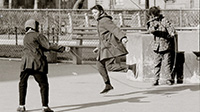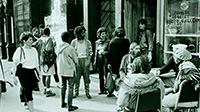While New York was the city of dreams for some, Black artists like Alex Harsley experienced a different scene. Born in the late ’30’s in South Carolina, he set his sights on New York in 1948…and eventually found his calling – photography – and much more.

Through his 4th Street Photo Gallery, he’s documented the daily life of New York City, fostered young talent, and documented the Black experience and Black leaders, musicians and personalities.
Diversity and History
Harsley has curated his 4th Street Photo Gallery and The Minority Photographers non-profit since the early ’70’s. (His own reportage style of photography started in 1958 as the first black photographer for the New York City District Attorney.) Since then he has continued to capture the true intimate moments and personality of New York City in all its diversity. His collection contains the historical lineage of musicians, politicians, street folk, landscapes and neighbors from the 1950’s through present day. His documentary medium consists of film, digital photography and digital sound and video.
“I was always practicing how to tell a story through a picture, tell a story in a detailed way.”
A long circuitous route
It wasn’t until 1957-1958 that Harsley would become a professional photographer; he had received a camera as a gift and subsequently “took the camera apart to understand how cameras work.” That launched his quest. He then began his own study of photography and the mechanics of a camera, steps that would pave the way for the 4th St Photo Gallery.
“Before the war, there were underground movements like the Black Art Movement and Harlem Renaissance, but after the war, there was a resurgence in Black arts and opportunity.”
Harsley soon landed a job as a messenger for the District of Attorney’s Office. “l would use that opportunity to query the photography department,” Harsley chuckles. “Working there gave me the attitude to navigate the city how I wanted. Before the war, there were underground movements like the Black Art Movement and Harlem Renaissance, but after the war, there was a resurgence in Black arts and opportunity. Photography had finally begun to open up to more diverse groups.”
Out on his own
However, Harsley wasn’t a follower, and quickly forged his own path by working for himself. “I was always practicing how to tell a story through a picture, tell a story in a detailed way. Most of the pictures I’ve taken have become historical in nature.” After building up his portfolio and establishing an aesthetic,

he worked in a color lab and taught photography through a nonprofit. He later opened up a gallery of his own – all of which would establish Harsley as a key player in the photography industry in New York.
“I was brave enough to pioneer and open up a space for our work. I didn’t know what I was getting into…getting into the arts was dangerous and political. It was important to stay in the background to help the movement, help others adopt a frame of reference to build their lives and history on.”
Inspirations and Aspirations
When asked about his deepest inspirations Harsley quickly replies “Augusta Savage…she created a vessel for artists to get to their destination. The arts scene in Harlem imploded due to the energy her work attracted. And despite circumstances during that time, we were able to accomplish so much and deepen the cultural fabric of the world.”
When Harsley wasn’t being inspired by other artists, he would be his own inspiration. “I would give myself assignments and I would challenge myself and capture photos of people on the corner, their different expressions, the skyline…occasionally I would get assignments or I would work with different artists, or find work in museums.” Harsley joyfully describes capturing Civil Rights Leaders like Coretta Scott King and the likes of Muhammad Ali, Harsley’s first major customer.
“I didn’t come to New York with that dream, I came with an aspiration. I never had the feeling to be rich, but to be somebody. My work exists to show what’s possible.”
Want to know more? Watch this video:
As Harsley embraces the rise of digital archiving and the internet to broaden his reach, he invites the public to bring their questions to his space for ongoing conversation. The 4th St Photo Gallery is open everyday from 1PM-12AM. There you can see some of Harsley’s favorite works including: past New York architecture, John Coltrane and Ray Charles at The Apollo Theatre, a series on Muhammad Ali, and more.
Photo Credits:
Lincoln Projects, 1959 Alex Harsley
Window Art, 1990 Alex Harsley
Top: Photographer James Maher 2014






